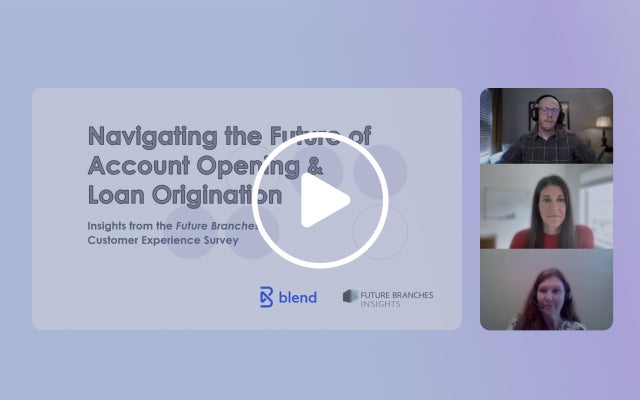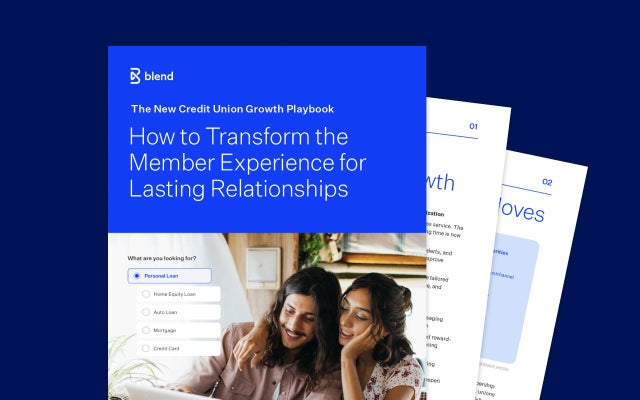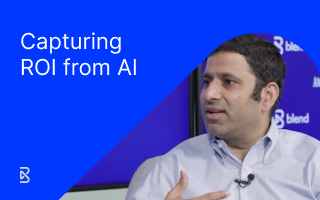October 7, 2020 in Thought leadership
How financial institutions can improve the customer experience for millennials

Two years ago when my husband and I purchased our first home, we had no idea what we were getting ourselves into. We had no idea that we would lose sleep over the sheer number of documents, PDFs, and files that needed to be created, submitted, and uploaded, and even how to organize those files.
Things have improved since then as more lenders have embraced technology like Blend’s Digital Lending Platform, which minimizes manual paper processes and guides customers through a loan application in clear, easy to understand language.
To an increasing degree, financial institutions — really, companies of all kinds — need to keep modernizing their processes and do a better job of understanding and adapting to the millennial mindset. As I said during a recent episode of The Benchmark, powered by Blend, millennials are the largest combined consumer group on the planet and also the most engaged and interactive. We expect mobile-optimized solutions and seamless customer service. When it comes to financial services, we have embraced mobile banking and are digital first.
Because of our combined purchasing power, there is a lot at stake for any company.
The two questions lenders should be asking are: what expectations do millennials have and how do our banking services fulfill the needs of the millennial consumer?
Understanding and delivering what millennials want
Here are 10 core attributes that millennials value and expect:
- Convenience and mobile support.
- Quick self-service solutions such as digital FAQs, how-to explainer videos, information-based blogs, and chatbots.
- Communications received via their preferred channels, including mobile apps, texting, and websites.
- An omnichannel approach. Millennials value digital touchpoints as well as the ability to talk to a financial adviser when needed.
- Trustworthy guidance. Bankers can provide much-needed direction on key money topics such as budgeting and managing debt.
- Security and fraud protection.
- Transparency in consumer information.
- State-of-the-art mobile banking services that allow users to set personalized alerts and automate tasks to help them stay on top of their finances by notifying them when it’s time to pay bills or when their balances are getting low.
- Sustainable solutions that help reduce the excessive volume of printed documents such as personalized card carriers, inserts and PIN mailers, as well as paper products.
- Convenience and efficiency. Having to wait 2-3 business days for a new PIN for a debit/credit card is an outdated practice. Luckily there are better alternatives available today. For example, a PIN code can be delivered instantly via a banking app, bank website, or SMS. This not only gives customers an innovative and more seamless experience, but also allows banks to reduce their carbon footprint.
Improving the loan application process
Mobile and online applications need to be hassle-free, tailored to make the process as effortless as possible. Millennials want to be able to conduct their banking business from anywhere and at any time. Think about how millennials shop for other goods and services as they rely on companies like Amazon, Apple, and Netflix.
Banks can offer a more seamless and delightful consumer experience by:
- Making it easy to enter applicant information. Use drop-downs, auto-fill, and conditional fields (based on information already entered) to streamline data entry.
- Providing image capture on mobile devices for driver’s licenses, pay stubs, address verifications, and other required documentation.
- Using optical character recognition (OCR) to automatically extract data from captured documents.
- Thoroughly testing and refining the user mobile experience.
A well-designed mobile loan application process is the beginning of a positive consumer experience. It captures required information quickly and lays the foundation for rapid decision-making.
Learning to speak the language of the millennial generation
Go one step deeper and narrow down the micro-markets within the millennial generation you want to reach. Customize your messaging, content, advertising, and influencer opportunities to speak their language.
Here are the six millennial micro markets I have created and teach companies about. Check out my YouTube video in which I talk more about these audience segments.
- 18-22 Gen Z-Millennial Cuspers: College students, interns, not making good money, still relying on mom and dad. Hyper-connected college campus virality.
- 23-26 Boomerang Babies: Recent college graduates, looking for work, living with mom and dad due to the high cost of living and/or debt.
- 27-30 Millennial Hustlers: Just starting to rock and roll with their career or starting their first business, beginning to earn and save.
- 31-34 Millennial Mom and Dad: Priorities are changing, more desire to become a homeowner, expand families and take on more responsibilities. More bills. Millennial moms happen to be among the most influential and collaborative blogger communities. A lot of millennial moms’ purchasing decisions are due to their blogger communities, reviews, and testimonials for brands or services.
- 35-37 Millennial-Gen X Cuspers: These adults are on the cusp of both the millennial generation and Generation X. Cuspers have already had their first or second child, are either buying or living in their first home, and have a different maturity and income level.
- 38-40 Millennials @ Heart: This group is unique because they’re likely to identify as millennials OR NOT. They have embraced the next-gen lifestyle and understand the social media landscape and the need to communicate and engage online. This consumer group is most active on Facebook, Twitter, and Linkedin.
To show up authentically to meet modern-day borrower demands, lenders must understand — and embrace — the mindset, needs, and pain points of their target millennial consumer.
Find out what we're up to!
Subscribe to get Blend news, customer stories, events, and industry insights.


